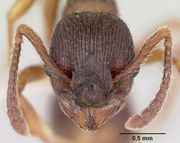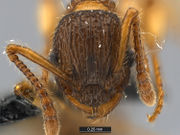Key to New England Myrmica
This key is modified from the 2012 book A Field Guide to the Ants of New England
.
Related pages:
1
- Antennal scape viewed in full profile is evenly curved near its base . . . . . 2
- Antennal scape viewed in full profile is bent abruptly near its base at a nearly 90° (right) angle; there is often a thick lamina or other outgrowth on the dorsal surface of the bend . . . . . 11
2
return to couplet #1
- Anterior margin of clypeus distinctly notched; if notch is shallow, propodeal spines are short (lobifrons group) . . . . . 3
- Anterior margin of clypeus usually without a notch; if a very shallow notch is present, the clypeus bulges outward in the middle and the propodeal spines are long . . . . . 4
3
return to couplet #2
- Clypeus deeply and distinctly notched; propodeal spines long and pointed rearward at an ~45° angle and with tips that curve gently downward; a bog specialist . . . . . Myrmica lobifrons
- Clypeus shallowly notched; propodeal spines short and pointing straight upward; a boreal species known in New England only from White Mountains of New Hampshire . . . . . Myrmica brevispinosa
4
return to couplet #2
- Coarse, large punctures (pits) at the base of the erect hairs on the top of the gaster; level of propodeum noticeably lower than the level of the promesonotum (punctiventris group) . . . . . 5
- No, or at best fine, inconspicuous punctures at the base of the erect hairs on the top of the gaster; level of propodeum more or less even with the level of the promesonotum . . . . . 7
5
return to couplet #4
- Propodeal spines short with thickened base; large triangular process visible below the petiole; a temporary social parasite of Myrmica punctiventris . . . . . Myrmica semiparasitica
- Propodeal spines long with narrow base; triangular process below the petiole inconspicuous . . . . . 6
6
return to couplet #5
- Propodeal spines longer than the distance separating their tips and often wavy; frontal lobes extend upward at a shallow angle, exposing the insertion of the antennae; rugae thick, but flattened on top . . . . . Myrmica punctiventris
- Propodeal spines shorter than the distance separating their tips and usually straight; frontal lobes flat to the head, often with a distinct downward deflection at their edges, and covering the insertion of the antennae; rugae thick and rounded on top . . . . . Myrmica pinetorum
7
return to couplet #4
- Viewed from above, frontal lobes thin, and pointed upwards, exposing the insertion of the antennae; clypeal margin with small indentations; an introduced Palearctic species common along coasts and rivers, as well as in urban disturbed areas . . . . . Myrmica rubra
- Viewed from above, frontal lobes thick and laterally extended, at least partially covering the insertion of the antennae; clypeal margin entire, without small indentations (incompleta group) . . . . . 8
8
return to couplet #7
- Head, clypeus, mesosoma, and petiole heavily sculptured and striated; lower surface of petiole with at most a small outgrowth or process; top of post-petiole in side view evenly (straight) sloped . . . . . 9
- Ant weakly sculptured, if at all; lower surface of petiole with a large, process; top of post-petiole hump-shaped in profile; inquiline social parasites; if workers are present, they lack the process under the petiole and instead are workers of the host species . . . . . 10
9
return to couplet #8
- Ant of deciduous forests; clypeus bulges in the middle and straight or modestly concave on the margin; rugae on top of the head anastomosing and net-like . . . . . Myrmica incompleta
- Ant of boreal forests; clypeus evenly convex in the middle and distinctly convex on the margin; rugae on top of the head parallel . . . . . Myrmica alaskensis
10
return to couplet #8
- Process below the petiole conical and angular; ant shiny, with virtually no sculpturing; an inquiline social parasite of Myrmica alaskensis . . . . . Myrmica lampra
- Process below the petiole large, rectangular, and blunt; not very shiny, with light sculpturing; an inquiline social parasite of Myrmica alaskensis . . . . . Myrmica quebecensis
11
return to couplet #1
- Antennal scape tapered on both sides, giving it a ridge on top and a triangular appearance in cross-section; a Palearctic, non-native species . . . . . Myrmica scabrinodis
- Antennal scape not tapered, giving it a rounded shape in cross-section; Nearctic, native species . . . . . 12
12
return to couplet #11
- Mesosoma, petiole, and post-petiole with thick, parallel, rugae that would appear round in cross-section; in full-face view, lateral wings of clypeus extended and raised anteriorly into a ridge that encloses the antennal socket; in dorsal view, lamella on the antennal bend are most apparent on the interior side, not on top, of the bend (sculptilis group) . . . . . 13
- Mesosoma, petiole, and post-petiole with thinner, net-like, anastomosing rugae that would appear sharply-angled in cross-section; in full-face view, lateral wings of the clypeus usually not raised anteriorly into a ridge that encloses the antennal socket; but if the clypeal wings are raised and enclose the antennal socket, then the lamella on the top of the antennal bend, in dorsal view, is apparent and well developed . . . . . 14
13
return to couplet #12
- In full-face view, frontal lobes large and rounded, covering the antennal socket; in dorsal view, antennal scape with a small outgrowth/lamella that is not wider than the base itself and with a ridge running along the inside of the base (towards the head). . . . . Myrmica sp. AF-scu - an undescribed species
- Frontal lobes smaller and with a convex margin, not covering the antennal socket; margin of the frontal lobes may have two separate ridges; in dorsal view, the lamella on the base of the scape is wider than the base itself . . . . . Myrmica sp. AF-smi - an undescribed species
14
return to couplet #12
- In dorsal view, the shaft of the antennal scape is distinctly narrower at the bend than it is at its apex; the lamina on the dorsal part of the antennal bend may extend downwards towards the head, but never extends along the scape itself (detritinodis group) . . . . . 15
- In dorsal view, the shaft of the antennal scape is more or less uniformly wide across its entire length; the lamina on the dorsal part of the scape does not extend downwards towards the head, but may extend anteriorly along the scape itself . . . . . 18
15
return to couplet #14
- Propodeum without spines; rugae create a spider-web pattern on the head, and anastomosing rugae on the sides . . . . . Myrmica sp. AF-ine - an undescribed species
- Propodeum with spines, all castes present . . . . . 16
16
return to couplet #15
- In dorsal view, the bend of the antennal scape has a curved or transverse lamina that continues downwards along the inner side of the base (towards the head). Forested habitats . . . . . Myrmica detritinodis
- In dorsal view, the lamina at the bend of the antennal scape is restricted to the top of the scape and does not run downwards along the base of the antenna; open and forest-edge habitats . . . . . 17
17
return to couplet #16
- In dorsal view, the lamina at the bend of the scape is small and barely visible; a widespread ant of open habitats in northern New England . . . . . Myrmica fracticornis
- In dorsal view, the lamina at the bend of the scape is large and conspicuous; an uncommon, boreal species . . . . . Myrmica cf. AF-sub - an undescribed species
18
return to couplet #14
- Lower surface of post-petiole is lobed and projecting forward when viewed in profile . . . . . Myrmica latifrons
- Lower surface of post-petiole is flat; in profile, post-petiole is slightly convex, but not lobed (nearctica group) . . . . . 19
19
return to couplet #18
- In full-face view, lateral wings of clypeus are raised into a ridge that encloses the antennal socket; margin of frontal lobes are evenly rounded over most of their length; in dorsal view, lamella at antennal bend is spoon-shaped, not extending along the inner (posterior) side of the scape towards its apex . . . . . 20
- In full-face view, lateral wings of clypeus flattened and not enclosing the antennal socket; margin of frontal lobes rounded towards the front but straight or convex posteriorly; in dorsal view, lamella at antennal bend large, and the lamina extends along the inner margin of the scape anteriorally towards its apex . . . . . Myrmica nearctica
20
return to couplet #19
- In dorsal view, the bend of the antennal scape has a large, circular, spoon-like lamella that projects sharply upward . . . . . Myrmica americana
- In dorsal view, the bend of antennal scape with a smaller lamella that is barely deflected inwardly, giving it a shallow spoon-shape . . . . . Myrmica sp. AF-eva - an undescribed species




























